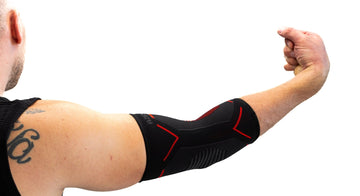How to Use an Elbow Sleeve to Manage Tendonitis: A Comprehensive Guide
by Emily Jannet on Mar 11, 2024
Tendonitis, a common overuse injury, can be a source of persistent discomfort and limited mobility for many individuals. Whether you're an athlete, an office worker, or someone who engages in repetitive arm movements, tendonitis in the elbow can significantly impact your daily life. However, there are various methods to manage and alleviate the symptoms of tendonitis, and one effective tool in this regard is the elbow sleeve. In this comprehensive guide, we'll explore how to use an elbow sleeve to effectively manage tendonitis, providing insights into its benefits, proper usage, and other supportive strategies for recovery.
What is Tendonitis
Before delving into the specifics of managing tendonitis with an elbow sleeve, it's essential to understand what tendonitis is and its causes. Tendonitis refers to inflammation or irritation of a tendon, the thick cord that attaches muscle to bone. In the case of the elbow, common forms of tendonitis include tennis elbow (lateral epicondylitis) and golfer's elbow (medial epicondylitis). These conditions often result from repetitive motions, overuse of the elbow joint, or sudden strenuous activities.
Symptoms of tendonitis typically include pain, tenderness, and swelling around the affected area, along with difficulty in moving the elbow joint without discomfort. While rest, proper stretching, and strengthening exercises are fundamental to managing tendonitis, using an elbow sleeve can provide additional support and relief during daily activities.
Benefits of Using an Elbow Sleeve
An elbow sleeve is a compression garment designed to provide support and stability to the elbow joint. It offers several benefits for individuals dealing with tendonitis:
Compression: The snug fit of an elbow sleeve applies gentle pressure to the affected area, which helps reduce inflammation and swelling, relieving pain associated with tendonitis.
Warmth and Circulation: The material of an elbow sleeve retains heat, promoting improved blood circulation to the injured tendon. Enhanced circulation aids in the delivery of oxygen and nutrients to the tissues, facilitating the healing process.
Support and Stability: By compressing the elbow joint, an elbow sleeve offers stability during movement, reducing strain on the tendons and preventing further injury. This support is particularly beneficial during activities that involve repetitive arm motions or gripping.
Increased Proprioception: Proprioception refers to the body's awareness of its position in space. Wearing an elbow sleeve can enhance proprioceptive feedback, helping individuals maintain proper alignment and posture while performing tasks, thus minimizing strain on the affected tendon.
How to Use an Elbow Sleeve Effectively
To maximize the benefits of an elbow sleeve in managing tendonitis, it's essential to use it correctly:
Choose the Right Size: Elbow sleeves come in various sizes, so it's crucial to select one that fits snugly around your elbow without being too tight or constrictive. Refer to the manufacturer's sizing guide to determine the appropriate size for your elbow circumference.
Wear During Activities: Wear the elbow sleeve during activities that aggravate your tendonitis symptoms, such as lifting objects, typing, or playing sports. Additionally, wearing the sleeve during periods of rest can provide continuous support and aid in the healing process.
Proper Positioning: Position the elbow sleeve so that it covers the affected area snugly, with the compression evenly distributed around the elbow joint. Ensure that the sleeve doesn't bunch up or slide down during movement, as this may compromise its effectiveness.
Gradual Adjustment: If you're new to wearing an elbow sleeve, gradually increase the duration of wear to allow your body to adjust to the compression. Start with short intervals and gradually extend the wearing time as tolerated.
Combine with Other Treatments: While an elbow sleeve can provide significant relief, it's essential to complement its use with other treatments for tendonitis management, such as rest, ice therapy, stretching exercises, and over-the-counter pain medications if necessary. Consult with a healthcare professional for personalized recommendations based on your specific condition.

Additional Strategies for Tendonitis Management
In addition to using an elbow sleeve, adopting the following strategies can further aid in managing tendonitis and promoting recovery:
Rest and Avoid Overuse: Give your elbow adequate rest to allow the injured tendon to heal. Avoid activities that exacerbate your symptoms or put strain on the elbow joint.
Gentle Stretching and Strengthening Exercises: Incorporate gentle stretching and strengthening exercises into your daily routine to improve flexibility and muscle strength around the elbow joint. Consult with a physical therapist or healthcare provider for guidance on appropriate exercises for your condition.
Ergonomic Modifications: Make ergonomic adjustments to your work or sports equipment to reduce strain on your elbows. This may include using ergonomic keyboards, adjusting desk height, or using proper technique during sports activities.
Ice Therapy: Apply ice packs to the affected area for 15-20 minutes several times a day to reduce inflammation and alleviate pain. Be sure to wrap the ice pack in a cloth to prevent direct skin contact and avoid prolonged exposure.
Maintain a Healthy Lifestyle: Eat a balanced diet rich in anti-inflammatory foods, stay hydrated, and prioritize adequate sleep to support overall healing and well-being.
Managing tendonitis in the elbow requires a multifaceted approach, and using an elbow sleeve can be an effective component of a comprehensive treatment plan. By providing compression, support, and stability to the affected joint, an elbow sleeve can help alleviate pain, reduce inflammation, and promote healing. However, it's essential to use the sleeve correctly and combine its use with other supportive strategies for optimal results. Remember to consult with a healthcare professional for personalized advice and recommendations tailored to your specific condition. With proper management and care, you can effectively manage tendonitis and return to your daily activities with reduced discomfort and improved mobility.





